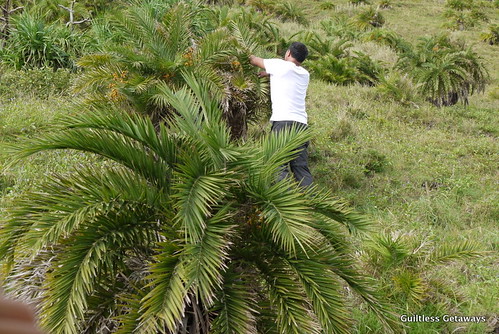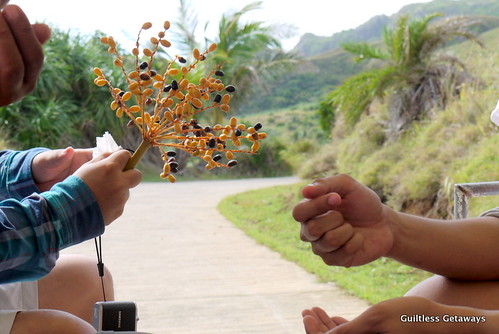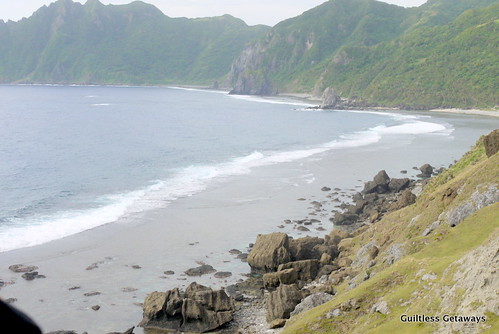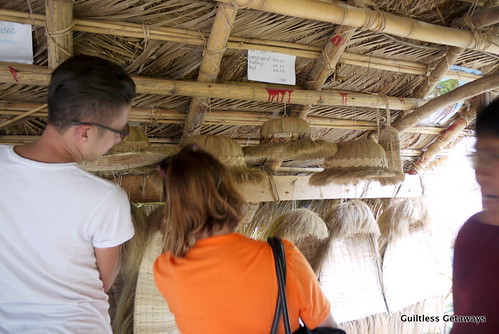When in Batanes, a daytrip to Sabtang Island should be part of your itinerary. You'll see the locals, trees, villages, houses, animals, food, beach, lighthouses, cliffs, views (even fortresses) and many more! It's very accessible by boat then rented jeep from Batan Island (where Basco is). Check out Part 1 on how to go to Sabtang from Batan or Basco and some things to remember. Part 2 is about what else you must not miss which are two of my favorite parts of the trip - the palm trees and the village of Chavayan! We didn't stay there long but I loved every moment of it while I saw the trees all throughout the island =)
We agree to go to the farthest point next to avoid the other groups of tourists. I just love the beautiful Philippine date palm trees (voyavoy or vuyavuy or voyavoi, the Ivatan language is full of "v"s hehe) and they're all over the island especially plenty on the more mountainous parts. The Ivatans use it to make walis (local sturdy broom, they say it's better than the walis tambo!) and vacul or vakul (a traditional Ivatan all-weather headgear that look like blond hair for the rain and sun, see below worn in Chavayan for samples) :) The trees also bear fruits. The ripe black ones are sweet and tasted like grainy chico!
It took us around 25 minutes from the port to reach the Chavayan village. Before the village shows itself to you, the views of the wave-cut cliffs with the water in greens, blues and whites are breathtaking that you may want to grab both your camera and phone while holding on tight for the zigzag turns at the same time haha. I knew at this point the importance of a driver's skill in these parts. They only have one small lane, in most parts, for both directions!
The small village is home to the Sabtang Weavers Association and there's a hut where you can wear the vacul for a minimal fee. Here's the male version kanayi with the talugung or talugong hat modelled by Ivan hehe.
Do I look dashing as a blondie with bangs? Haha. The headwear was actually kinda heavy but I guess protects well and every household here must have had it long before the Spaniards came. They say it's relatively hotter in Sabtang than in other Batanes islands and there were drizzles throughout the day here so they can use it all year-round by women farmers (also when they attend to their farm). They even have a nail-type comb to keep it buhaghag-free! Haha. If you want to buy the vacul then I think it's cheaper here at around 700. Look at their big feather-duster too! That I'm willing to use and the broom (can be bought in Ignas' Handicraft and Souvenir Shop in Batan)! Haha.
As for the all-weather gear, we can all get lightweight eyeglasses fitted in optical shops with Transitions photochromic lenses and windbreakers to block UV rays at 100% and a bucket hat (from galleon.ph) nowadays ;)
From a cultural perspective though, the Ivatan culture and language (as well as the Batanes landscape) are so unique that you have to go all the way there just to experience it for yourself and not a lot of people get to do that. I hope UNESCO recognizes Batanes as a heritage treasure already.
Do I look dashing as a blondie with bangs? Haha. The headwear was actually kinda heavy but I guess protects well and every household here must have had it long before the Spaniards came. They say it's relatively hotter in Sabtang than in other Batanes islands and there were drizzles throughout the day here so they can use it all year-round by women farmers (also when they attend to their farm). They even have a nail-type comb to keep it buhaghag-free! Haha. If you want to buy the vacul then I think it's cheaper here at around 700. Look at their big feather-duster too! That I'm willing to use and the broom (can be bought in Ignas' Handicraft and Souvenir Shop in Batan)! Haha.
From a cultural perspective though, the Ivatan culture and language (as well as the Batanes landscape) are so unique that you have to go all the way there just to experience it for yourself and not a lot of people get to do that. I hope UNESCO recognizes Batanes as a heritage treasure already.
You generally have to be invited before you go in people's houses but just look around, befriend someone and notice the little things. You'll already get a sense of the way of living here. There's an old well near the entrance of the village.
A slow walk is a must in this small place. I reached the end of the village in 15-20 minutes. Some of the old limestone houses are still in good condition (you can find more typical Ivatan stone houses in Barangay Savidug along the National Road) and I heard it's possible to do a homestay here. The walls are more than a meter thick and had remained standing through Batanes' ever-changing weather conditions and super typhoons. The only catch is no electricity at night to early morning, but you'll have basic accommodations and local food. Well, the better you can do some stargazing, right?
One of the friendly people I met here is Nanay Fely who has a picture with Coco Martin and other celebrities hehe. She was just going about her usual supply gathering while still wearing a basket and vacul :)
She has a very warm twinkle in her eyes. I wish Nanay the best of health for more smiles. On a sidenote, Roger said that the older people here could speak better English because of the missionaries that came here a long time ago.
No more than 15 minutes and you'll reach the only chapel, the Sta. Rosa de Lima Chapel, left with the cogon roof.
Check out the baskets hanging in the houses also. Roger said that Ivatans use it to store luniz or lonyes (preserved salted pork) because they didn't have a fridge then (probably until now in this far off community).
You'll see the long coast soon if you walk a little farther. Batanes is closer to Taiwan than Manila - they said they receive Chinese radio signal hehe.
It's easy to fall in love with this place, noh? By this time, you would have already forgotten the white caps and headwind that supposedly make the journey back rougher. Haha.
















































